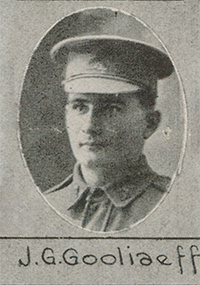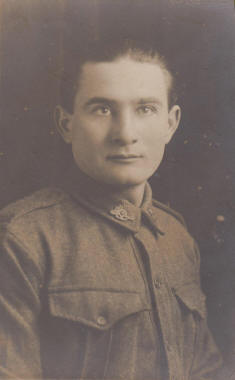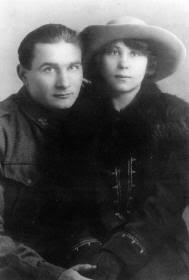Justin George Gooliaeff
| Russian spelling | Устин Георгиевич Гуляев |
|---|---|
| Born | 29.05.1892 |
| Place | Dolgie Budy, Kursk, Russia |
| Ethnic origin | Russian |
| Religion | Russian Orthodox |
| Father | George Theodor Gooliaeff, timber merchant |
| Mother | Anastasia Gooliaeff |
| Family | Wife Violet Maud Gooliaeff (née Mullock), married 1918 in London, son George Walter b. 1919, London, daughter Lilly Veronica b. 1921, Brisbane |
| Residence before arrival at Australia | Studied 1 year at Moscow University |
| Arrived at Australia |
from Vladivostok on 31.01.1913 per Yawata Maru disembarked at Brisbane |
| Residence before enlistment | Rockhampton, Qld |
| Occupation | 1916 labourer, boilermaker, 1920, 1922 French polisher, 1920s farming and cane-cutting |
| Naturalisation | 1922 |
| Residence after the war | Brisbane, Cairns, Innisfail, soldiers' settlement El-Arish, North Queensland |
| Died | 13.10.1925, Innisfail, Qld |
Service #1
| Service number | 30088 |
|---|---|
| Enlisted | 5.05.1916 |
| Place of enlistment | Rockhampton, Qld |
| Unit | 3rd FAB, 4th DAC, 11th FAB, 4th Division MTM Battery |
| Rank | Gunner |
| Place | Western Front, 1917-1918 |
| Final fate | RTA 10.12.1918 |
| Discharged | 31.03.1919 |
Materials
Digitised naturalisation (NAA)
Digitised service records (NAA)
Digitised Embarkation roll entry (AWM)
Alien registration (NAA)
Blog article
Publications
Елена Говор, Революционеры, анзаки и пионеры: к истории ранних курско-австралийских связей, "В боях познавшие радость побед..." Курский военно-исторический сборник, вып. 11, Курск, 2013, с. 36-54.
Newspaper articles
Central district volunteers. - Capricornian, Rockhampton, 13 May 1916, p. 7.
Killed by a tree. - Cairns Post (Qld.), 16 November 1925, page 8
From Russian Anzacs in Australian History:
'When World War I broke out', Justin Gooliaeff's son George relates, 'he decided to join the 1st AIF: his idea was that if a country was worth living in it was worth fighting for.'
[...] Among those who were returned 'on account of Russian nationality' there were several men who had made no application to be discharged, and were not in any case noted for radical inclinations: John Siwezynski, who was decorated with a Belgian Croix de Guerre, Nicholas Korotcoff, Justin Gooliaeff, George Sekachoff (all from artillery units), and Richard Gregorenko from the 14th Field Ambulance. This selection of men, fuelled by the Russian scare, seems rather arbitrary. Nearly all of them were from the 4th Division (its 11th Field Artillery Brigade, where Smagin had earlier served, was completely purged of Russians); other divisional commanders did not bother to purge their ranks of Russians.
[...] Another well-educated Russian to take on the challenge of the land was Justin Gooliaeff. He had married in England just before he was purged from the AIF 'on account of Russian nationality' and his wife, with their newborn son George, soon followed him out to Queensland. George recalls that his father 'was a qualified French polisher but his idea was that a man should do a man's work, that's the reason he took the farm on. ... My father drew a block of land in El Arish, north Queensland, with an assignment to grow sugar cane ... Like all ex-servicemen, my father was granted, on a long-term lease, a piece of north Queensland scrub (actually jungle), a loan of about £600 for the purpose of building a house, and the right to grow sugar cane on a restricted scale. In order to generate income so that he could develop his farm (and maintain his family) my father spent the early period cane-cutting in the Innisfail district -- a hard, back-breaking job -- and then on Friday night he would walk about 20 miles to his block of land, spend the weekend working on it, and then walk back to Innisfail to spend the weekdays cutting cane. After my father had developed his farm to a sufficient extent, and had his house constructed, my mother, with my sister and myself, moved up from Brisbane to live with him.' [...]
Justin Gooliaeff, spared the death of an Anzac, died an Australian pioneer. His son tells what happened. 'Everything went along very well until 1925 -- the farm prospered, and my family were due to have a trip to England the following year to visit my mother's relations. However, in 1925 a neighbouring farmer, in the middle of a very hot north Queensland summer, left some of the stumps in his property burning (in those early days many paddocks were still 'unstumped') and in an effort to cut a break and save as many farms as possible (the cane was due for harvesting) my father was running along a "headland" with other farmers, when the top of a burning tree (about 60 feet I believe) burnt off, fell down, and hit my father on the top of his head, killing him instantly.' Memories of Gooliaeff persisted for a long time in the district.
Gallery

Justin Gooliaeff
Queenslander Pictorial, supplement to The Queenslander, 27 January 1917, p. 25

Photo of Justin Gooliaeff given to Osiph Rinkevich, France, 1918
Courtesy of Osiph Rinkevich's family

Justin and Violet Gooliaeff
Courtesy of George Gooliaeff
 Russian Anzacs
Russian Anzacs